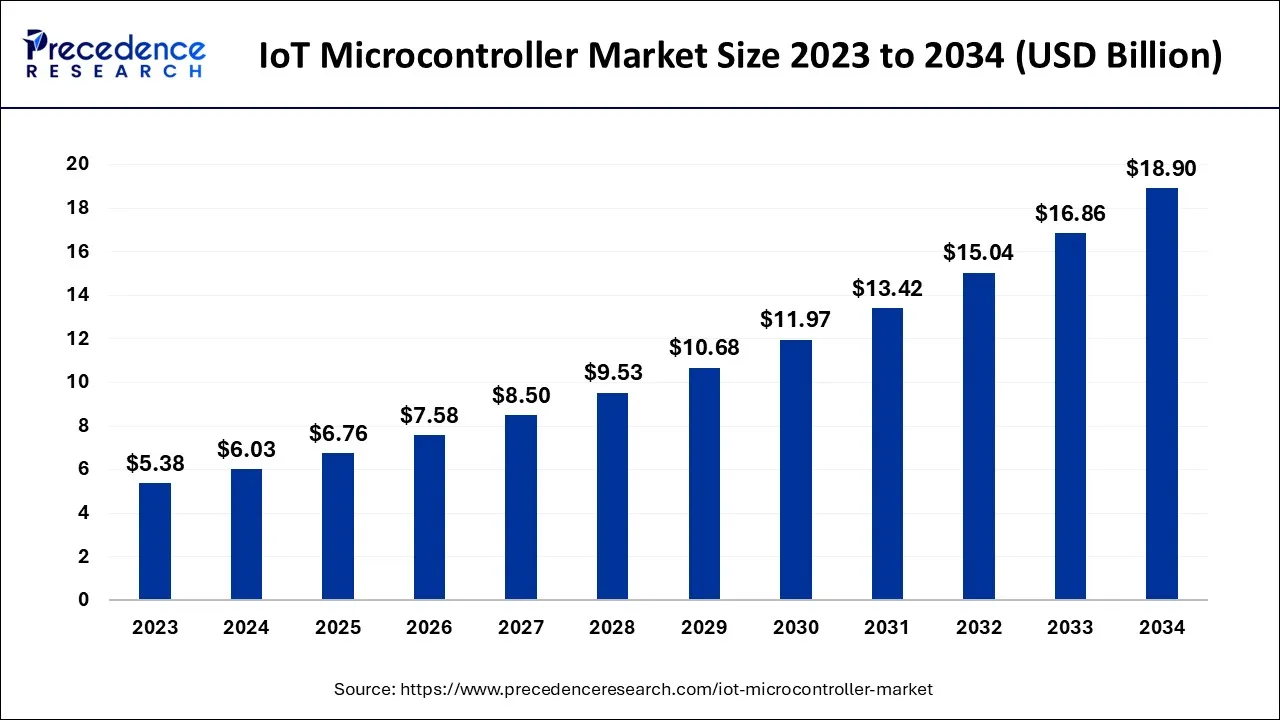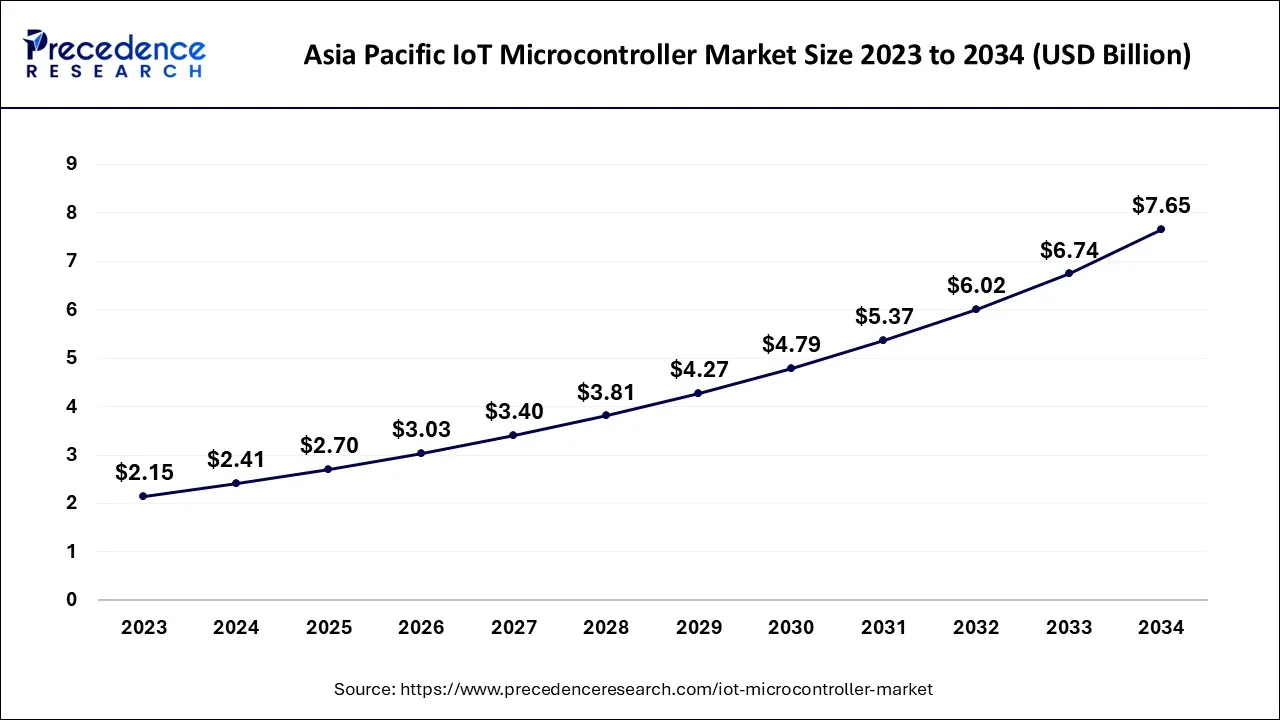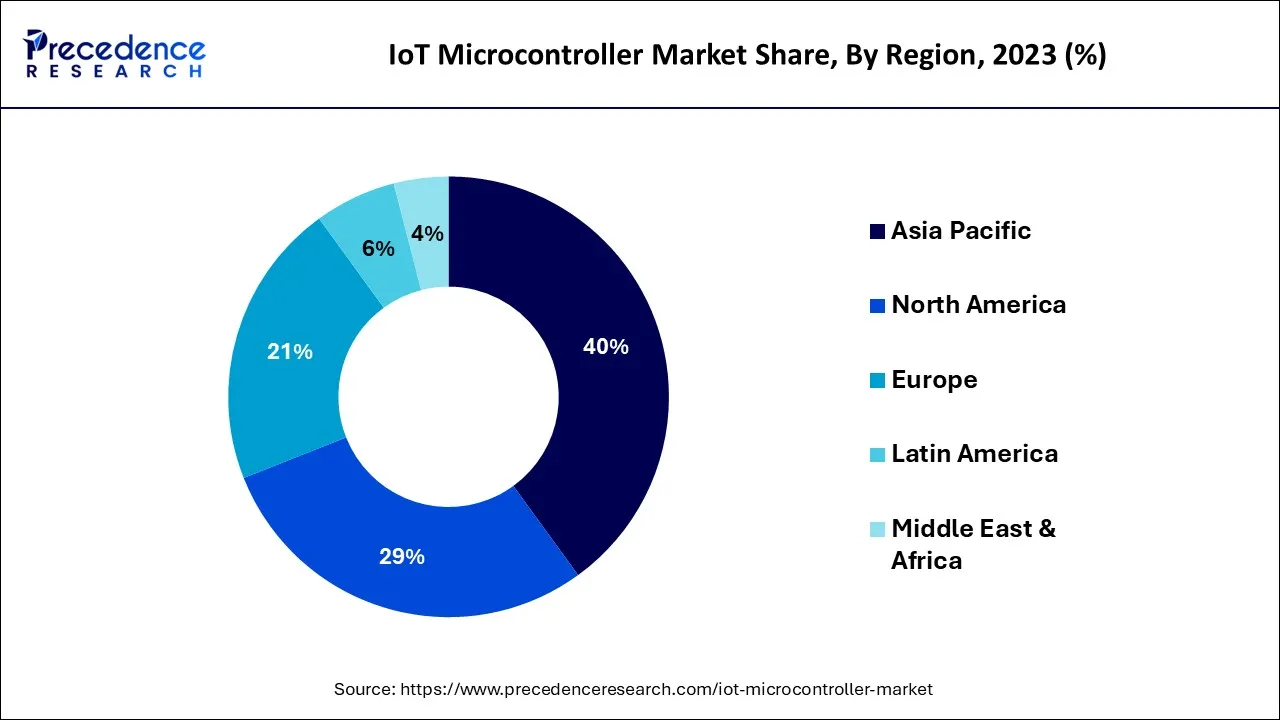What is IoT Microcontroller Market Size?
The global IoT microcontroller market size is expected to be valued at USD 6.76 billion in 2025 and is anticipated to reach around USD 18.90 billion by 2034, expanding at a CAGR of 12.1% over the forecast period from 2025 to 2034.

Market Highlights
- Asia Pacific led the global market with the highest market share of 40% in 2024.
- By product, the 32-bit MCU segment dominated the market with a revenue share of 41% in 2024 and is growing at a CAGR of 13.7% between 2025 and 2034.
- The 8-bit MCUs segment is expanding at a registered CAGR of 12.1% during the forecast period.
- The wearables segment is expanding at a CAGR of 13.2% from 2025 to 2034.
What is the IoT Microcontroller?
A microcontroller is a small integrated circuit that controls a single process in an embedded system. A typical microcontroller is a single chip that houses a CPU, memory, and input/output (I/O) peripherals. Due to advances in communication, microelectronics, and information technology, the idea of the Internet of Things (IoT) has been widely applied in a variety of industries, including smart cities, smart homes, consumer electronics, automation and so forth. The Internet of Things (IoT) and smart devices frequently employ microcontrollers (MCUs) to supply computational power. These are essentially mini computers that give smart devices access to memory, processing power, and peripherals for input and output.
Microcontrollers are designed to carry out certain functions and are used in a variety of applications, such as wearable technology, industrial gear, warehouse inventories, home appliances, and more. As a result of IoT's extensive uses in the digitally connected world, microcontroller integration with IoT has become increasingly popular. Some of the key reasons driving the market expansion are the rising number of IoT connections between the consumer and business sectors and the demand for connected items with high performance, low power consumption, and low energy consumption.
IoT Microcontroller Market Growth Factors
Growing Internet of Things (IoT) technological breakthroughs, a sharp increase in the number of connected devices, and a more interconnected infrastructure are some of the factors boosting market demand. The business is also getting a boost from the rising number of autonomous and electric vehicles that utilize linked infrastructure. The Internet of Things refers to the networking of several devices. IoT is used by self-driving cars, for instance, to update their algorithms depending on input from users. A few other key factors driving the industry's expansion are rising digitization, an increase in smartphone shipments, and the development of 5G technology.
The coronavirus epidemic has changed both how the semiconductor business operates and how society as a whole function. Business operations on the microcontrollers market have slowed down as a result of a severe chip scarcity. To create stable revenue streams despite the ongoing epidemic, manufacturers are concentrating on sectors with high growth potential like consumer electronics, healthcare, and IT.
- The demand for IoT microcontrollers is expected to rise in the predicted years as it has more demand than any other.
- IoT lead technology is used in almost every sector and has a great future hence, future of this product is expected to boom in the coming years.
IoT Microcontroller MarketTrends
- App controlled management: People started to live a smart life where they prefer to complete their daily action by the technology and hence, technology enabled devices are controlled using IoT which influences the sale.
- Changes in using home appliance products preference:Consumers are preferring IoT enabled products than previous due to its specifications and ease of doing actions. IoT has make the products look smarter and work efficiently.
- Cost Effective:The new advancements and ongoing research on IoT enabled sensor technology is expected to become cheaper which will influence the IoT microcontroller market in the coming days.
IoT Microcontroller Market Outlook
- Industry Growth Overview: The IoT microcontroller market is expanding rapidly, driven by the growing adoption of smart devices, connected systems, and industrial IoT applications. Increasing demand for low-power, high-performance MCUs, coupled with advancements in wireless connectivity and edge computing, further accelerates market growth.
- Miniaturization of Microcontrollers: A key trend involves the ongoing reduction in size of microcontrollers, opening up possibilities for compact wearables and smart devices. There is also a push for more powerful 32-bit and 64-bit microcontrollers with enhanced security and edge AI features to manage complex applications locally.
- Global Expansion: The market is expanding worldwide, with significant growth opportunities across emerging regions driven by increased investments in infrastructure, digitalization, and modern manufacturing technologies.
- Major Investors: Large semiconductor and technology companies such as Intel, NXP Semiconductors, STMicroelectronics, and Infineon Technologies are major investors. Investment is also driven by end-user industries and research initiatives focused on secure, low-power, and next-generation connectivity.
- Startup Ecosystem: A vibrant startup ecosystem focuses on niche innovations in specialized microcontrollers, security solutions, and software integration. Startups are attracting funding to develop advancements in areas such as specialized chips for data centers and AI, and technologies to extend battery life.
Market Scope
| Report Coverage | Details |
| Market Size in 2025 | USD 6.76 Billion |
| Market Size in 2026 | USD 7.58 Billion |
| Market Size by 2034 | USD 18.90 Billion |
| Growth Rate from 2025 to 2034 | CAGR of 12.1% |
| Largest Market | Asia Pacific |
| Base Year | 2023 |
| Forecast Period | 2025 to 2034 |
| Segments Covered | Product, Application, and Regions |
| Regions Covered | North America, Europe, Asia-Pacific, Latin America, and Middle East & Africa |
Market Dynamics
Market Drivers
Increasing Demand for Wearables
- Intelligent gadgets known as wearables can be integrated in clothing, implanted in the user's body, or worn as accessories. Wearables can be combined with IoT technology thanks to the downsizing of sensors and advancements in modern technologies like Artificial Intelligence, Machine Learning, and Big Data Analytics. People are motivated to pursue fitness-related activities and use wearables to track their performance by lifestyle factors like obesity.
- Wearables are continuously improving in terms of ergonomics, product material, battery life, storage capacity, functionality, performance, and usability as a result of the realization that size, weight, power consumption, durability, ruggedness, reliability, and ease of use are some of the crucial factors end users are taking into account when making a purchasing decision for wearable devices. The adoption of wearables is anticipated to be fueled by the millennial generation's growing preference for fitness wearables.
Fleet management places a strong emphasis on operational efficiency
- IoT can be utilized in a variety of fleet management applications, including asset tracking, fleet route planning, and predictive fleet maintenance, to improve operational flexibility and enable logistics and transportation businesses to spend less on both capital and operational expenses. An emerging technology called IoT in fleet management enables extremely high operational efficiencies in logistics and transportation processes. Fleet management service providers now have more prospects thanks to the digitalization of vehicles, the unrelenting growth of the transportation and logistics sectors, and other factors.
- The primary factor supporting the implementation of IoT in fleet management has been the growing desire to reduce costs while enhancing operational efficiencies and boosting profitability. Moreover, real-time monitoring of vehicle data is possible with the aid of IoT technology in conjunction with sensors, cameras, navigation systems, and mobile portable devices. Fleet management with IoT has made it simple to track and monitor important vehicle data and driver performance. The expanding use of IoT in fleet management is encouraging for the market for IoT microcontrollers during the upcoming years.
Market Challenges
- Design Challenges- The market could be hampered, though, by design challenges in high-speed and power-critical applications. Because of their low price and small size, manufacturers are spending money on research and development to create cutting-edge microcontrollers.
- High Power Consumption- During the projection period, it is anticipated that the microcontroller's high-power consumption would be a significant issue impeding the market growth.
Segment Insights
Product Insights
According to product type, the 32-bit MCU segment is in the lead and is anticipated to contribute most to the IoT microcontroller market. 32-bit MCUs are the most adaptable for use in Internet of Things applications. It processes multiple peripherals efficiently, is widely used in industrial applications including factory automation and building automation, and is also competitively priced. Because they can execute arithmetic operations on 32-bit values, 32-bit microcontrollers perform operations faster than other microcontrollers. They can complete operations in less instruction cycles thanks to its wider data bus. As a result of the increased need for IoT everywhere, businesses have started releasing 32-bit microcontrollers constantly.
Over the projection period, it is anticipated that the 8 Bit MCUs market would grow significantly. For low-power applications like connected devices and smart wearables, the 8-bit segment is widely employed. The adoption of wearables is anticipated to be fueled by the millennial generation's increased demand for fitness wearables. Obesity and other lifestyle diseases encourage people to engage in various fitness-related activities and track their progress using wearables, which is projected to be positive for the market's growth over the coming years.
Application Insights
During the projected period, the smart homes segment is anticipated to be the largest in the IoT microcontroller market. Home appliances are included in the smart home category. A trend that is anticipated to support the market growth for the smart home segment over the coming years is the increase in demand for safe, secure, and energy-efficient applications like HVAC and energy management, lighting, and infotainment. This is especially true of app-controlled smart devices, particularly mobile apps.
Consumer electronics segment is expected to grow significantly. Smartphones, wearable technology, and other items fall under the consumer electronics category. The staff were forced to work remotely due to the COVID-19 outbreak. This has increased the demand for smart devices like fitness trackers and smartwatches. Wearables sales are anticipated to increase over the next few years due to millennials' rising fitness and health consciousness. IoT MCU sales are therefore anticipated to be driven by the use of low-power MCUs along with short-range wireless communication, particularly 8 bit combined with Bluetooth/KNX/Zigbee/Wi-Fi-based protocols, over the forecast period.
Regional Insights
Asia Pacific IoT Microcontroller Market Size and Growth 2025 to 2034
The Asia Pacific IoT microcontroller market size accounted for USD 2.7 billion in 2025 and is projected to be worth around USD 7.65 billion by 2034, poised to grow at a CAGR of 12.24% from 2025 to 2034.

During the forecast period, Asia-Pacific is expected to maintain its dominant position. The key driving forces behind the expansion are China, India, and Japan, which collectively accounted for more than 50% of the market share. Rising demand for smart wearables and favorable government investment to assist initiatives for smart cities can be credited with this. The recent Regional Comprehensive Economic Partnership (RCEP) trade agreement between China and ASEAN nations, as well as the surge in disposable income in growing economies like Vietnam, Malaysia, and Indonesia, should allow consumers to buy smart home gadgets at competitive costs. Ultimately, this will fuel market expansion over the projection period.
Why is Europe Considered the Second-Largest Region in the Market?
Europe is considered as second largest region in the IoT microcontroller market. This region includes UK, Germany, and France. As part of ambitious expenditures in grid modernization, more than 50% of the electricity meters in Europe have been replaced by smart meters. The installation of smart meters in European nations like France, Spain, and the U.K. has been especially accelerated by favorable government investments, which supports the market expansion over the forecast period. All of these elements should create chances for market participants to increase profitability, which is positive for the market growth of IoT microcontrollers throughout the forecast period.

India IoT Microcontroller Market Trends
India is a rapidly growing market, mainly fueled by strong domestic demand, a big push for digital infrastructure, and fast industrialization. Government programs like Digital India and the Smart Cities Mission increase the need for affordable IoT solutions in large-scale applications, with efforts also underway through the India Semiconductor Mission to develop local chip design and manufacturing capabilities.
Germany IoT Microcontroller Market Trends
Germany is a mature market supported by its globally recognized engineering expertise and a strong focus on Industry 4.0 and high-value manufacturing. The demand for IoT microcontrollers across various applications, such as automotive electronics, industrial control systems, and complex sensor networks, is significant. Home to global technology leaders, the market is greatly influenced by a dedication to innovation and the adoption of advanced microcontrollers that facilitate secure and efficient IoT ecosystems.
How is North America Emerging in the IoT Microcontroller Market?
North America plays a vital role in the IoT microcontroller market, fueled by early and widespread adoption of connected devices and substantial investments in research and development. The region leads in deploying high-performance, secure microcontrollers (MCUs) for industrial automation, smart homes, and advanced applications in automotive and healthcare sectors. With major global companies present and a strong emphasis on enhanced security, North America continues to influence global market trends.
U.S. IoT Microcontroller Market Trends
The U.S. leads the North American IoT microcontroller market, driven by technological advances and the development of low-power, high-performance MCUs. Efforts in the U.S. focus on developing high-performance 32-bit MCUs with advanced security features, edge AI capabilities, and built-in wireless connectivity. Government programs, like the CHIPS and Science Act, provide billions in funding to boost domestic manufacturing, promote research, and reduce dependence on foreign suppliers.
What Potentiates the Latin American IoT Microcontroller Market?
The Latin American market is experiencing steady growth, driven by rising smartphone penetration and expanding connectivity infrastructure. The region is concentrating on modernizing various industries, especially logistics, automotive, and agriculture, which is driving demand for IoT solutions and the microcontrollers that power them. Government initiatives aimed at digital transformation and a growing awareness of operational efficiencies are promoting wider adoption of IoT technology.
Brazil IoT Microcontroller Market Trends
Brazil is a significant player in the market, with growth driven primarily by the country's initiatives in industrial automation and smart city projects. The country's large automotive sector also drives demand, integrating IoT microcontrollers for advanced driver assistance systems (ADAS) and connectivity features. Supported by local technology hubs and a growing startup ecosystem, Brazil's market benefits from strong domestic demand for innovative, connected solutions across multiple industries.
What Factors Drive the Growth of the Market in the Middle East & Africa?
The IoT microcontroller market in the Middle East & Africa (MEA) is driven by extensive infrastructure development, smart city initiatives, and a strong push for economic diversification toward technology. The demand for advanced sensing and control technologies in building automation, energy management, and the oil and gas sectors is a key growth driver. Investments in large-scale projects and a rising awareness of energy efficiency are accelerating the adoption of IoT devices and the microcontrollers that enable their functionality.
UAE IoT Microcontroller Market Trends
The UAE plays a key role in the IoT microcontroller market, driven by its ambitious technological goals and smart city projects like Dubai Smart City. The country is heavily investing in IoT infrastructure for building automation, security, and connected logistics. There is also rising demand in the healthcare sector for connected medical devices. As a regional hub for technology and innovation, the UAE is speeding up the adoption of advanced IoT solutions.
Value Chain Analysis
- Intellectual Property & Core Technology
This stage involves designing chip architecture.
Key Players: ARM Holdings, RISC-V International, and specialized IP vendors. - Research and Development (R&D)
Companies are developing new MCU architectures with features such as edge AI, security, and connectivity.
Key Players: STMicroelectronics, Infineon Technologies, NXP Semiconductors, and Texas Instruments. - Manufacturing and Production
This involves the physical fabrication of integrated circuits (ICs) using materials such as silicon wafers.
Key Players: TSMC, UMC, Infineon, STMicroelectronics, and NXP. - System Integration & Ecosystem Support
Manufacturers and third parties create hardware and software ecosystems, including development boards and SDKs.
Key Players: STMicroelectronics, NXP, Arduino, ESP-IDF, Amazon AWS, and Microsoft Azure. - Distribution and Sales
Finished MCUs and development kits are distributed to customers.
Key Players: DigiKey and Arrow Electronics.
Top Companies for the IoT Microcontroller Market and Their Offerings
- Infineon Technologies: IoT MCUs focusing on robust security (SECORA) and connectivity for smart homes and industrial automation.
- Microchip Technology Inc.: Extensive range of 8, 16, and 32-bit MCUs (PIC, AVR, SAM) with integrated wireless connectivity options.
- NXP Semiconductors: ARM Cortex-M based MCUs (MCX, i.MX RT) for secure automotive, industrial, and smart city applications.
- STMicroelectronics: Versatile and low-power STM32 MCUs with a rich development ecosystem for smart home and industrial use.
- Texas Instruments Inc.: Energy-efficient MCUs with integrated wireless connectivity (Wi-Fi, Bluetooth) for industrial and automotive IoT.
Other Key Players
- Broadcom
- Espressif Systems (Shanghai) Co., Ltd
- Holtek Semiconductor Inc.
- Nuvoton Technology Corporation
- Silicon Laboratories
- Renesas Electronics Corporation
Recent Developments
- The first Wi-Fi 6E client device, BCM4389, was introduced by Broadcom Inc. A smartphone combo chip called the BCM4389 provides speeds of over 2 Gbps and improved battery life for smartphones as well as potential augmented reality (AR) and virtual reality (VR) applications.
Segments covered in the report
By Product
- 8 Bit
- 16 Bit
- 32 Bit
By Application
- Industrial Automation
- Smart Homes
- Consumer Electronics
- Smartphones
- Wearables
- Others
- Others (Smart Utility, Smart Transportation& Logistics, Smart Retail, and other enterprise application)
By Region
- North America
- Europe
- Asia-Pacific
- Latin America
- Middle East & Africa (MEA)
For inquiries regarding discounts, bulk purchases, or customization requests, please contact us at sales@precedenceresearch.com
Frequently Asked Questions
Ask For Sample
No cookie-cutter, only authentic analysis – take the 1st step to become a Precedence Research client




 sales@precedenceresearch.com
sales@precedenceresearch.com
 +1 804-441-9344
+1 804-441-9344